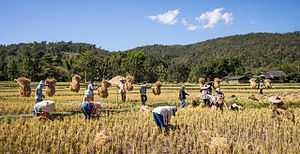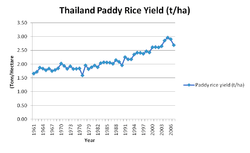Rice production in Thailand

Rice production in Thailand represents a significant portion of the Thai economy and labor force.[1]
Thailand has a strong tradition of rice production. It has the fifth-largest amount of land under rice cultivation in the world and is the world's second largest exporter of rice.[2] Thailand has plans to further increase the land available for rice production, with a goal of adding 500,000 hectares to its already 9.2 million hectares of rice-growing areas.[3]
The Thai Ministry of Agriculture expects rice production to yield around 30 million tons of rice in 2008.[4] Jasmine rice, a higher quality type of rice, is the rice strain most produced in Thailand. Jasmine has a significantly lower yield rate than other types of rice, but it normally fetches more than double the price of other strains on the global market.[3]
Pre-World War II history
Until the 1960s, rice planting in Thailand consisted mainly of peasants farming small areas and producing modest amounts of rice. The Chao Phraya River delta was the hub of rice production.[5] Agriculture constituted a large portion of the total production of Thailand and most Thais worked on farms. The extreme focus on agriculture arose for two main reasons: the vast amount of land available for farming and the government's policies of clearing land and protecting peasants' rights. The government helped peasants gain access to land and protected them from aristocratic landlords.[5]
Due to the government's stance, urban merchants were unable to gain much control over the Thai rice industry. The government concerned itself with protecting farmers and not with overall production. As a result, Thailand was relatively self-sufficient, resistant to government intervention, and egalitarian. Most rice farmers owned their own land and exchanged labor between farmers was common. Rice production normally was not much more than the farmers needed to survive on.[5]
Post-World War II history
As Europe was starting to come together on many issues including agricultural policy (including price supports), Thailand was starting to protect its rice farmers less and work with the merchants more. The government started worrying about increasing production and extracting more surplus from the rice industry.[5] Thailand turned to the merchants to put on this pressure and it worked very well.[5]

Governmental policy

The government sought to promote urban growth. One of the ways it accomplished this was by taxing the rice industry and using the money in big cities.[5] In fact, during 1953, tax on rice accounted for 32% of governmental revenue. The government set a monopoly price on exports, which increased tax revenues and kept domestic prices low in Thailand. The overall effect was income transfer from farmers to the government and to urban consumers (who purchased rice). These policies on rice were called the "rice premium," which was used until 1985 when the government finally gave into political pressure.[5] The shift away from protecting the peasant rice farmers by the government moved the rice industry away from the egalitarian values that were enjoyed by farmers to more of a modern-day, commercial, profit-maximizing industry.[5]
The Thai government had strong incentives to increase rice production and they were successful in most of their plans. The government invested in irrigation, infrastructure, and other pro-rice projects. The World Bank also provided finance for dams, canals, locks, ditches, and other infrastructure in the Greater Chao Phraya Project. Pro-small farm mechanization policies protected agro-machinery manufacturers from outside competition. They also stimulated small machinery R&D that resulted by the late-1990s in nearly 2 million locally-produced two-wheel tractors, as well as 1 million axial flow pumps for irrigation, hundreds of thousands of small horsepower rice threshers, and 10,000 small horsepower caterpillar track-propelled combines that are able to harvest in small, fragmented, and still wet fields [6]
With the combination of improved access to water and machinery, these policies prompted rice farms to increase from 35 million to 59 million rai from the 1950s to the 1980s.[5] Rice production has about tripled in terms of total paddy rice produced. While Thailand's rice production has not increased every year, the trend line shows significant increases since the 1960s.
Increased production


A large portion of this rapid expansion was due to increased production of rice in northeast Thailand[7] While in the past, central Thailand was the main producer of rice, northeast Thailand quickly caught up. This was in part due to new road systems connecting northeast Thailand to ports on the coastline. Villages that produced significant rice crops were also changing as farmers evolved from more subsistence practices to mostly wage labor. Exchange labor also virtually disappeared.[7]
Cows were being replaced by farm tractors and irrigation technology was updated in most villages. The green revolution was just starting to bloom in the world's farm fields. Rice farmers and merchants took advantage of new rice varieties, strains, fertilizers, and other advances.[7] The International Rice Research Institute (IRRI) disseminated knowledge, technology, new rice strains, and other information to rice producers in Thailand. From the 1950s to 1970s, rice production per unit of land increased by almost 50%.[5]
Thailand exported 10.8 million tons of milled rice valued at US$5.37 billion in 2014, the highest figures in its history. The Thai Commerce Ministry expects this to vault Thailand back to the number one spot among rice exporting nations. 2014 rice exports represented an increase of 64% in volume and 22% value in compared to 6.6 million tonnes worth US$4.42 billion exported in 2013.[8]
Effects on low-income farmers
While all of these advances helped improve overall production of rice in Thailand, many low-income farmers in Thailand were left worse off. Many peasants were unable to hold onto to their land and became tenants.[5] The government demamded tax revenues, even during bad years, and this pushed many low-income farmers even closer to the margin. New technologies also pushed up the entry cost of rice farming and made it harder for farmers to own their land and produce rice.[5]
Farmers who already had large scale operations or could afford all the new chemicals, rice strains, and tractors benefited greatly while the average peasant was turned from a land-owning rice producer to a manual laborer on the farms of others.[5]
Importance of rice
Rice is central to Thai society.[9] Rice uses over half of the arable land and labor force in Thailand. It is one of the main foods and sources of nutrition for most Thai citizens. Rice is also a major Thai export. Despite its importance to the nation, the industry is under threat. According to Setboonsarng, the top three threats are, "(i) increase in competition in the international market; (ii) growing competition with other economic activities that increases the cost of production, especially the labour cost; and (iii) degradation of ecological conditions. Rice research has to address these challenges."[9]
As the world becomes economically "flatter", and the rice production around the world become more competitive, it becomes harder for Thailand to keep its competitive advantage and the margins Thai rice producers have been used to. For the second threat, the modernization of Thailand has led to an increase in wealth and the cost of labor, making it more expensive for rice farmers to hire inexpensive manual labor. Third, intensive cultivation of land used for rice culture may have long-term adverse effects on crop yields.
Traditions
Rain-making ceremonies are common for rice farmers in Thailand. One such ceremony happens in Bangkok and involves the lord of the Royal Plowing Ceremony throwing rice kernals as he walks around the Grand Palace as the crown prince of Thailand watches.[7] Another tradition that is common to central Thailand is a "cat procession". This involves villagers parading a cat around and throwing water at it, in the belief that a "crying" cat brings a fertile rice crop.[7]
Possible cartel
Thailand has at times considered creating a rice cartel with Vietnam, Burma, Laos, and Cambodia. The purpose would be to control production and set prices similar to the OPEC cartel that controls production of oil. Thailand had even submitted a proposal to the other countries for the organization, but it was retracted in 2008. Many analysts believe that such a price-setting organization will not work due to the lack of cooperation between all of the countries and their lack of control over farmer's production. Thailand is now looking at creating a more forum-based international organization to discuss supplies and yields of rice.[10]
Noppadon Pattama, the foreign minister of Thailand, wants to call the forum the "Council on Rice Trade Cooperation" and was planning, as of May 2008, to invite China, India, Pakistan, Cambodia, Burma, and Vietnam to join. Pattama has also said the potential new international forum will not replicate any of the work done by the International Rice Research Institute.[10] The institute was formed in 1960 to, "…improve the health of rice farmers and consumers, and ensure that rice production is environmentally sustainable" in Southeast Asia.[11]
See also
References
- ↑ "Country Profile: Thailand" (PDF). Library of Congress. Washington DC: Federal Research Division. Jul 2007. Retrieved 2015-01-10.
- ↑ "Thailand wants rice top spot back". Investvine.com. 2013-02-01. Retrieved 2013-02-14.
- ↑ 3.0 3.1 "Rice strain is cause of comparatively low productivity." The Nation (Thailand) 16 Apr 2008. 2 Feb. 2009 .
- ↑ Nirmal, Ghost. "Thailand to set aside more land for farming; It plans to increase rice production and stop conversion of agricultural land." Straits Times (Singapore) 24 Apr 2008.
- ↑ 5.0 5.1 5.2 5.3 5.4 5.5 5.6 5.7 5.8 5.9 5.10 5.11 5.12 Pasuk Phongpaichit, and Christopher John Baker. Thailand, Economy and Politics. Kuala Lumpur: Oxford University Press, 1995.
- ↑ Thepent, Viboon. 2009. "Agricultural Mechanization Development in Thailand" .
- ↑ 7.0 7.1 7.2 7.3 7.4 Perehudoff, Carol. "Thailand's miracle grain for all seasons; Humble rice has the power to feed, cleanse, fight ravages of time." Toronto Star [Toronto] 30 Jun 2007.
- ↑ "Commerce Ministry: Rice export for 2014 the highest in history". Thai PBS. Thai Commerce Ministry. 2015-01-19. Retrieved 2015-01-20.
- ↑ 9.0 9.1 Evenson, Robert E., Robert W. Herdt, and Mahabub Hossain. "Rice Research in Asia: Progress and Priorities". Wallingford, UK: CAB International in association with the International Rice Research Institute, 1996.
- ↑ 10.0 10.1 "Thailand backs away from rice cartel plan." International Herald Tribune, 7 May 2008: 12. 2 Feb 2009 .
- ↑ IRRI Home Site - Frontpage. 2 Feb 2009 .
| Wikimedia Commons has media related to Rice farming in Thailand. |
| ||||||||